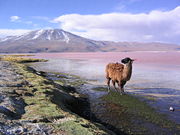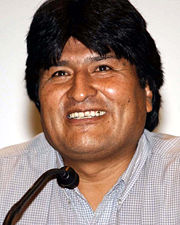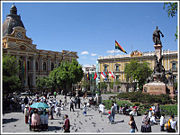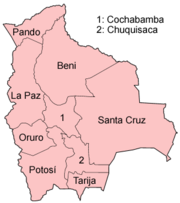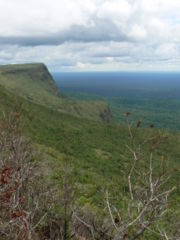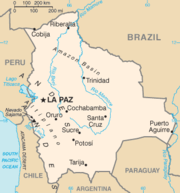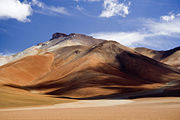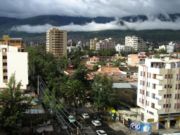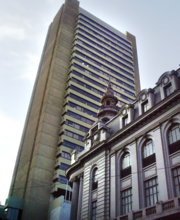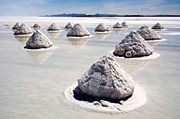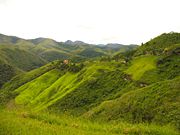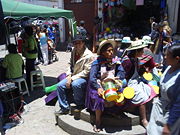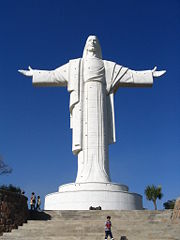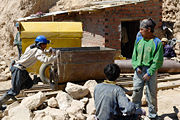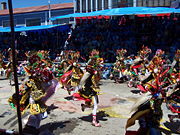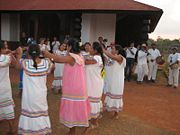Bolivia
2008/9 Schools Wikipedia Selection. Related subjects: Americas; Countries
| República de Bolivia (Spanish) Bulibya Republika (Quechua) Wuliwya Suyu (Aymara) Republic of Bolivia
|
||||||
|---|---|---|---|---|---|---|
|
||||||
| Motto: "¡La unión es la fuerza!" (Spanish) "Unity is strength!" |
||||||
| Anthem: Bolivianos, el hado propicio (Spanish) |
||||||
|
|
||||||
| Capital | Sucre (constitutional, judicial) La Paz (administrative) |
|||||
| Largest city | Santa Cruz de la Sierra |
|||||
| Official languages | Spanish, Quechua, Aymara | |||||
| Demonym | Bolivian | |||||
| Government | Republic | |||||
| - | President | Evo Morales | ||||
| - | Vice President | Álvaro García | ||||
| Independence | ||||||
| - | from Spain | August 6, 1825 | ||||
| Area | ||||||
| - | Total | 1,098,581 km² ( 28th) 424,163 sq mi |
||||
| - | Water (%) | 1.29 | ||||
| Population | ||||||
| - | July 2007 estimate | 9,119,152 ( 84th) | ||||
| - | census | 8,857,870 | ||||
| - | Density | 8.4/km² ( 210th) 21.8/sq mi |
||||
| GDP ( PPP) | estimate | |||||
| - | Total | $25.684 billion ( 101st) | ||||
| - | Per capita | $2,817 ( 125th) | ||||
| GDP (nominal) | 2007 estimate | |||||
| - | Total | $12.8 billion ( 108rd) | ||||
| - | Per capita | $1,422 ( 121st) | ||||
| Gini (2002) | 60.1 (high) | |||||
| HDI (2007) | ▲ 0.695 (medium) ( 117th) | |||||
| Currency | Boliviano ( BOB) |
|||||
| Time zone | ( UTC-4) | |||||
| Internet TLD | .bo | |||||
| Calling code | +591 | |||||
The Republic of Bolivia (Spanish: República de Bolivia, Spanish pronunciation: [reˈpuβ̞lika ð̞e β̞oˈliβ̞ja]), named after Simón Bolívar, is a landlocked country in central South America. It is bordered by Brazil on the north and east, Paraguay and Argentina on the south, and Chile and Peru on the west. From 1839 Sucre was the seat of government until the administrative capital was moved to La Paz in 1898. Sucre remains the constitutional capital and seat of the Supreme Court (Corte Suprema de Justicia).
History
Colonial period
The territory now known as Bolivia was called "Upper Peru" and was under the authority of the Viceroy of Lima. Local government came from the Audiencia de Charcas located in Chuquisaca (La Plata—modern Sucre). By the late 16th century Bolivian silver was an important source of revenue for the Spanish empire. A steady stream of natives served as labor force (the Spanish employed the pre-Columbian draft system called the mita). As Spanish royal authority weakened during the Napoleonic wars, sentiment against colonial rule grew.
The Republic and economic instability (1809)
The struggle for independence started in 1809, and after 16 years of war the republic was proclaimed on August 6, 1825, named for Simón Bolívar (see Bolivian War of Independence).
In 1836, Bolivia, under the rule of Marshal Andres de Santa Cruz, invaded Peru to reinstall the deposed president, General Luis Orbegoso. Peru and Bolivia formed the Peru-Bolivian Confederation, with de Santa Cruz as the Supreme Protector. Following tensions between the Confederation and Chile, Chile declared war on December 28, 1836. Argentina, Chile's ally, declared war on the Confederation on May 9, 1837. The Peruvian-Bolivian forces achieved several major victories: the defeat of the Argentinian expedition and the defeat of the first Chilean expedition on the fields of Paucarpata near the city of Arequipa.
On the same field the Paucarpata Treaty was signed with the unconditional surrender of the Chilean and Peruvian rebel army. The treaty stipulated that Chile withdraw from Peru-Bolivia, return captured Confederate ships, economic relations would be normalized, and the Confederation would pay Peruvian debt to Chile. Public outrage over the treaty forced the government to reject it. Chile organized a second attack on the Confederation, and defeated it on the fields of Yungay using the same arms and equipment Santa Cruz had allowed them to retain. After this defeat, Santa Cruz fled to Ecuador, and the Peruvian-Bolivian Confederation was dissolved.
Following the independence of Peru, General Gamarra, the Peruvian president, invaded Bolivia, under the Peruvian flag. The Peruvian army was decisively defeated at the Battle of Ingaví on November 20, 1841, where Gamarra was killed. The Bolivian army under General José Ballivián then mounted a counter-offensive managing to capture the Peruvian port of Arica. Later, both sides signed a peace in 1842 putting a final end to the war.
A period of political and economic instability in the early to mid-19 century weakened Bolivia. Then in the War of the Pacific (1879–83) against to Chile, it lost its access to the sea, and the adjoining rich nitrate fields, together with the port of Antofagasta. Since independence, Bolivia has lost over half of its territory to neighboring countries because of wars. It also lost the state of Acre (known for its production of rubber) when Brazil persuaded the state of Acre to secede from Bolivia in 1903 (see the Treaty of Petrópolis).
In the late 1800s, an increase in the world price of silver brought Bolivia relative prosperity and political stability. During the early 20th century, tin replaced silver as the country's most important source of wealth. A succession of governments controlled by the economic and social elite followed laissez-faire capitalist policies through the first thirty years of the 20th century.
Living conditions of the native people, who constituted most of the population, remained deplorable. Forced to work under primitive conditions in the mines and in nearly feudal status on large estates, they were denied access to education, economic opportunity, and political participation. Bolivia's defeat by Paraguay in the Chaco War (1932–35) marked a turning-point.
Rise of the Nationalist Revolutionary Movement (1951)
The Nationalist Revolutionary Movement (MNR) emerged as a broadly based party. Denied its victory in the 1951 presidential elections, the MNR led the successful 1952 revolution. Under President Víctor Paz Estenssoro, the MNR , having strong popular pressure, introduced universal suffrage into his political platform, and carried out a sweeping land-reform promoting rural education and nationalization of the country's largest tin-mines.
Twelve years of tumultuous rule left the MNR divided. In 1964, a military junta overthrew President Estenssoro at the outset of his third term. The 1969 death of President René Barrientos Ortuño, a former member of the junta elected President in 1966, led to a succession of weak governments. Alarmed by public disorder and the rising Popular Assembly, the military, the MNR, and others installed Colonel (later General) Hugo Banzer Suárez as President in 1971. Banzer ruled with MNR support from 1971 to 1974. Then, impatient with schisms in the coalition, he replaced civilians with members of the armed forces and suspended political activities. The economy grew impressively during most of Banzer's presidency, but human rights violations and eventual fiscal crises undercut his support. He was forced to call elections in 1978, and Bolivia again entered a period of political turmoil.
Military governments: García Meza and Siles Zuazo (1978)
Elections in 1979 and 1981 were inconclusive and marked by fraud. There were coups d'état, counter-coups, and caretaker governments. In 1980, General Luis García Meza Tejada carried out a ruthless and violent coup d'état that did not have popular support. He pacified the people by promising to remain in power only for one year. (At the end of the year, he staged a televised rally to claim popular support and announced, "Bueno, me quedo," or, "All right; I'll stay [in office]." He was deposed shortly thereafter.) His government was notorious for human-rights-abuses, narcotics-trafficking, and economic mismanagement; during his presidency, the inflation that later crippled the Bolivian economy could already be felt. Later convicted in absentia for various crimes, including murder, García Meza was extradited from Brazil and began serving a 30-year sentence in 1995.
After a military rebellion forced out García Meza in 1981, three other military governments in 14 months struggled with Bolivia's growing problems. Unrest forced the military to convoke the Congress elected in 1980 and allow it to choose a new chief executive. In October 1982, Hernán Siles Zuazo again became President, 22 years after the end of his first term of office (1956-60).
Sánchez de Lozada and Banzer: Liberalizing the economy (1993-2001)
Sánchez de Lozada pursued an aggressive economic and social reform agenda. The most dramatic reform was the "capitalization" program, under which investors, typically foreign, acquired 50% ownership and management control of public enterprises, such as the state oil corporation, telecommunications system, airlines, railroads, and electric utilities, in return for agreed upon capital investments. The reforms and economic restructuring were strongly opposed by certain segments of society, which instigated frequent and sometimes violent protests, particularly in La Paz and the Chapare coca-growing region, from 1994 through 1996. The de Lozada government pursued a policy of offering monetary compensation for voluntary eradication of illegal coca by its growers in the Chapare region. The policy produced little net reduction in coca, and in the mid-1990s Bolivia accounted for about one-third of the world's coca that was being processed into cocaine.
During this time, the umbrella labor-organization of Bolivia, the Central Obrera Boliviana (COB), became increasingly unable to effectively challenge government policy. A teachers' strike in 1995 was defeated because the COB could not marshal the support of many of its members, including construction- and factory-workers. The state also used selective martial law to keep the disruptions caused by the teachers to a minimum. The teachers were led by Trotskyites, and were considered to be the most militant union in the COB. Their downfall was a major blow to the COB, which also became mired in internal corruption and infighting in 1996.
In the 1997 elections, General Hugo Banzer, leader of the Nationalist Democratic Action party (ADN) and former dictator (1971-1978), won 22% of the vote, while the MNR candidate won 18%. General Banzer formed a coalition of the ADN, MIR, UCS, and CONDEPA parties, which held a majority of seats in the Bolivian Congress. The Congress elected him as president, and he was inaugurated on August 6, 1997. During the election-campaign, Banzer had promised to suspend the privatization of the state-owned oil-company, YPFB. But this seemed unlikely to happen, considering Bolivia's the weak position vis-à-vis international corporations. The Banzer government basically continued the free-market and privatization-policies of its predecessor. The relatively robust economic growth of the mid-1990s continued until about the third year of its term in office. After that, regional, global and domestic factors contributed to a decline in economic growth. Financial crises in Argentina and Brazil, lower world prices for export-commodities, and reduced employment in the coca-sector depressed the Bolivian economy. The public also perceived a significant amount of public-sector corruption. These factors contributed to increasing social protests during the second half of Banzer's term.
At the outset of his government, President Banzer launched a policy of using special police-units to physically eradicate the illegal coca of the Chapare region. The policy produced a sudden and dramatic four-year decline in Bolivia's illegal coca-crop, to the point that Bolivia became a relatively small supplier of coca for cocaine. Those left unemployed by coca-eradication streamed into the cities, especially El Alto, the slum-neighbourhood of La Paz. The MIR of Jaime Paz Zamora remained a coalition-partner throughout the Banzer government, supporting this policy (called the Dignity Plan).
On August 6, 2001, Banzer resigned from office after being diagnosed with cancer. He died less than a year later. Banzer's Vice President, Jorge Fernando Quiroga Ramírez, completed the final year of his term.
2002 elections
Quiroga was constitutionally prohibited from running for national office in 2002.
In the June 2002 national elections, former President Gonzalo Sánchez de Lozada (MNR) placed first with 29.5% of the vote, followed by coca-advocate and native peasant-leader Evo Morales ( Movement Toward Socialism, MAS) with 20.9%. Morales edged out populist candidate Manfred Reyes Villa of the New Republican Force (NFR) by just 700 votes nationwide, earning a spot in the congressional run-off against Sánchez de Lozada on August 4, 2002.
A July agreement between the MNR and the fourth-place MIR, which had again been led in the election by former president Jaime Paz Zamora, virtually ensured the election of Sánchez de Lozada in the congressional run-off, and on August 6 he was sworn in for the second time. The MNR platform featured three overarching objectives: economic reactivation (and job creation), anti- corruption, and social inclusion.
2005 elections
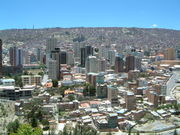
The 2005 Bolivian presidential election was held on December 18, 2005. The two main candidates were Juan Evo Morales Ayma of the Movement Toward Socialism (MAS) Party, and Jorge Quiroga, leader of the Democratic and Social Power (PODEMOS) Party and former head of the Acción Democrática Nacionalista (ADN) Party.
Morales won the election with 53.740% of the votes, an absolute majority unusual in Bolivian elections. He was sworn in on January 22, 2006 for a five-year term. Prior to his official inauguration in La Paz, he was inaugurated in an Aymara ritual at the archeological site of Tiwanaku before a crowd of thousands of Aymara people and representatives of leftist movements from across Latin America. Though highly symbolic, this ritual was not historically based and primarily represented native Aymaras — not the main Quechua-speaking population. Since the Spanish conquest in the early 1500s, this region of South America, with a majority native population, has been ruled mostly by descendants of European immigrants, with only a few mestizo (mixed European and indigenous) rulers. Morales, an Aymara, has stated that the 500 years of colonialism are now over and that the era of autonomy has begun.
His recent presidential election victory has also brought new attention to the US drug-war in South America and its heavy emphasis on coca-crop-eradication. The US-supported "Plan Dignidad" (dignity-plan), which seeks to reduce cocaine-production to zero, is seen by many Bolivians as an attack on their livelihoods and way of life. Morales, a leader among coca-growers, has said his government will try to interdict drugs, but he wants to preserve the legal market for coca-leaves and promote export of legal coca-products.
On May 1, 2006, Morales announced his intent to re-nationalize Bolivian hydrocarbon assets. While stating that the initiative would not be an expropriation, Morales sent Bolivian troops to occupy 56 gas-installations simultaneously. Troops were also sent to the two Petrobras-owned refineries in Bolivia, which provide over 90% of Bolivia's refining-capacity. A deadline of 180 days was announced, by which all foreign energy-firms were required to sign new contracts giving Bolivia majority ownership and as much as 82% of revenues (the latter for the largest natural-gas-fields). All such firms signed contracts. Reports from the Bolivian government and the companies involved are contradictory as to plans for future investment. By far the biggest customer for Bolivian hydrocarbons has been Brazil, which imports two-thirds of Bolivia's natural gas via pipelines operated by the huge semi-private Petrobras (PBR). Since gas can only be exported from landlocked Bolivia via PBR's large (and expensive) pipelines, the supplier and customer are strongly linked. PBR has announced plans to produce enough natural gas by 2011 to replace that now supplied by Bolivia. Bolivia's position is strengthened by the knowledge that hydrocarbon reserves are more highly valued now than at the times of previous nationalizations, and by the pledged support of President Hugo Chávez of Venezuela.
Fulfilling a campaign promise, Morales opened on August 6, 2006 the Bolivian Constituent Assembly to begin writing a new constitution aimed at giving more power to the indigenous majority. Problems immediately arose when, unable to garner the two-thirds votes needed to include controversial provisions in the constitutional draft, Morales' party announced that only a simple majority (50%+) would be needed to draft individual articles while two-thirds needed to pass the document in full. Violent protests arose in December 2006 in parts of the country for both two-thirds and departmental autonomy; mostly in the eastern third of the country, where much of the hydrocarbon wealth is located. Conservative sectors in this region threaten to secede from the nation if their demands are not met. MAS and its supports believed two-thirds voting rules would give an effective veto for all constitutional changes to the conservative minority. In August 2007, more conflicts arose in Sucre, as the city demanded the discussion of the seat of government inside the assembly, hoping the executive and legislative branch could return to the city, but assembly and the government said this demand was overwhelmingly impractical and politically undesirable. The conflict turned into violence, and the assembly was moved to a military area in Oruro. Although the main opposition party boycotted the session, a constitutional draft was approved on November 24. Subsequent riots, whipped up by opposition mercenary groups, left three dead.
In January 2007, a clash between middle class city dwellers and poorer rural campesinos killed 2 people and injured over 130 in the central city of Cochabamba. The campesinos had paralyzed the city by blockading the highways, bridges, and main roads, and days earlier had set fire to the departmental seat of government. The fire aimed to force the resignation of the elected Prefect of Cochabamba, Manfred Reyes Villa after he demanded a re-vote on departmental autonomy having been previously defeated by popular vote. The city dwellers broke up the blockade and routed the protesters, while the police did little to interfere on either side. Further attempts by the campesinos to reinstate the blockade and threaten the government were unsuccessful, but the underlying tensions have not been resolved.
Politics
The 1967 constitution, amended in 1994, provides for balanced executive, legislative, and judicial powers. The traditionally strong executive, however, tends to overshadow the Congress, whose role is generally limited to debating and approving legislation initiated by the executive. The judiciary, consisting of the Supreme Court and departmental and lower courts, has long been riddled with corruption and inefficiency. Through revisions to the constitution in 1994, and subsequent laws, the government has initiated potentially far-reaching reforms in the judicial system and processes.
Bolivia's nine departments received greater autonomy under the Administrative Decentralization law of 1995. Departmental autonomy further increased with the first popular elections for departmental governors (prefectos) on 18 December 2005, after long protests by pro-autonomy-leader department of Santa Cruz. Bolivian cities and towns are governed by directly elected mayors and councils. Municipal elections were held on 5 December 2004, with councils elected to five-year terms. The Popular Participation Law of April 1994, which distributes a significant portion of national revenues to municipalities for discretionary use, has enabled previously neglected communities to make striking improvements in their facilities and services.
The president is elected to a five-year term by popular vote. Elected president Gonzalo Sanchez de Lozada resigned in October 2003, and was substituted by Vice-president Carlos Mesa. Mesa was in turn replaced by chief justice of the Supreme Court Eduardo Rodríguez in June 2005. Six months later, on December 18, 2005, the Socialist native leader, Evo Morales, was elected president.
Legislative branch
Bolivia's government is a republic. The Congreso Nacional ( National Congress) has two chambers. The Cámara de Diputados ( Chamber of Deputies) has 130 members elected to five-year terms, seventy from single-member districts (circunscripciones) and sixty by proportional representation. The Cámara de Senadores ( Chamber of Senators) has twenty-seven members (three per department), elected to five-year terms.
Bolivia has had a total of 193 coups d'etat from independence until 1981, thereby averaging a change of government once every ten months. Credit for the past quarter century of relative political stability is largely attributed to President Víctor Paz Estenssoro, who ceded power peacefully after cutting hyperinflation which reached as high as 14,000 percent.
Military
The Bolivian military comprises three branches: an Army, Navy and Air Force. The legal age for voluntary admissions is 18; however, when the numbers are small the government recruits anyone as young as 14. It is estimated that 20% of the Bolivian army is between the ages 14 and 16 while another 20% is from 16 to 18. The tour of duty is generally 12 months. The Bolivian government annually spends $130 million on defense.
Departments and provinces
Bolivia is divided into nine departments (departamentos); capitals in parentheses:
- Beni ( Trinidad)
- Chuquisaca (Sucre)
- Cochabamba ( Cochabamba)
- La Paz (La Paz)
- Oruro ( Oruro)
- Pando ( Cobija)
- Potosí ( Potosí)
- Santa Cruz ( Santa Cruz de la Sierra)
- Tarija ( Tarija)
Additionally, the departments are further divided into 100 provinces (provincias), and the provinces are each divided into municipalities (municipios) and cantons (cantones), which handle local affairs.
Geography
At 1,098,580 km² (424,135 mi²), Bolivia is the world's 28th-largest country (after Ethiopia). It is comparable in size to Mauritania, and it has about 1.5 times the area of the US state of Texas.
Bolivia has been a landlocked nation since 1879, when it lost its coastal department of Litoral to Chile in the War of the Pacific. However, it does have access to the Atlantic via the Paraguay River.
An enormous diversity of ecological zones are represented within Bolivia's territory. The western highlands of the country are situated in the Andes Mountains and include the Bolivian Altiplano. The eastern lowlands include large sections of Amazonian rainforests and Chaco. The highest peak is Nevado Sajama at 6,542 metres (21,463 ft) located in the department of Oruro. Lake Titicaca is located on the border between Bolivia and Peru. The Salar de Uyuni, the world's largest salt flat, lies in the southwest corner of the country, in the department of Potosí.
Major cities are La Paz, El Alto, Santa Cruz de la Sierra, and Cochabamba.
Economy
Bolivia has the lowest GDP per capita figures in South America. The country is rich in natural resources, and has been called a "donkey sitting on a gold-mine" because of this.
Bolivia's 2002 gross domestic product (GDP) totaled USD $7.9 billion. Economic growth is about 2.5% a year, and inflation was expected to be between 3% and 4% in 2002 (it was under 2% in 2001).
Bolivia’s current lackluster economic situation can be linked to several factors from the past three decades. The first major blow to the Bolivian economy came with a dramatic fall in the price of tin during the early 1980s, which impacted one of Bolivia’s main sources of income and one of its major mining-industries. The second major economic blow came at the end of the Cold War in the late 1980s and early 1990s as economic aid was withdrawn by western countries who had previously tried to keep a market-liberal regime in power through financial support.
Since 1985, the government of Bolivia has implemented a far-reaching program of macroeconomic stabilization and structural reform aimed at maintaining price-stability, creating conditions for sustained growth, and alleviating scarcity. A major reform of the customs-service in recent years has significantly improved transparency in this area. The most important structural changes in the Bolivian economy have involved the capitalization of numerous public-sector enterprises.
Parallel legislative reforms have locked into place market-liberal policies, especially in the hydrocarbon- and telecommunication-sectors, that have encouraged private investment. Foreign investors are accorded national treatment, and foreign ownership of companies enjoys virtually no restrictions in Bolivia.
The government has a long-term sales-agreement to sell natural gas to Brazil through 2019. The government expects to hold a binding referendum in 2004 on plans to export natural gas.
In April 2000, Bechtel signed a contract with Hugo Banzer, the former president of Bolivia, to privatize the water-supply in Bolivia's third-largest city, Cochabamba. Shortly thereafter, the company tripled the water-rates in that city, an action which resulted in protests and rioting among those who could no longer afford clean water. Drawing water from community wells or gathering rainwater was made illegal. Amidst Bolivia's nationwide economic collapse and growing national unrest over the state of the economy, the Bolivian government was forced to withdraw the water contract.
Bolivian exports were $1.3 billion in 2002, from a low of $652 million in 1991. imports were $1.7 billion in 2002. Bolivian tariffs are a uniformly low 10%, with capital equipment charged only 5%. Bolivia's trade-deficit was $460 million in 2002.
Bolivia's trade with neighboring countries is growing, in part because of several regional preferential trade-agreements it has negotiated. Bolivia is a member of the Andean Community and enjoys nominally free trade with other member countries.
The United States remains Bolivia's largest trading-partner. In 2002, the United States exported $283 million of merchandise to Bolivia and imported $162 million.
Agriculture accounts for roughly 15% of Bolivia's GDP. Soybeans are the major cash crop, sold into the Andean Community market.
Bolivia's government remains heavily dependent on foreign assistance to finance development-projects. At the end of 2002, the government owed $4.5 billion to its foreign creditors, with $1.6 billion of this amount owed to other governments and most of the balance owed to multilateral development-banks. Most payments to other governments have been rescheduled on several occasions since 1987 through the Paris Club mechanism. External creditors have been willing to do this because the Bolivian government has generally achieved the monetary and fiscal targets set by IMF programs since 1987, though economic crises in recent years have undercut Bolivia's normally good record. The rescheduling of agreements granted by the Paris Club has allowed the individual creditor-countries to apply very soft terms to the rescheduled debt. As a result, some countries have forgiven substantial amounts of Bolivia's bilateral debt. The U.S. government reached an agreement at the Paris Club meeting in December 1995 that reduced by 67% Bolivia's existing debt-stock. The Bolivian government continues to pay its debts to the multilateral development banks on time. Bolivia is a beneficiary of the Heavily Indebted Poor Countries (HIPC) and Enhanced HIPC debt-relief-programs, which by agreement restricts Bolivia's access to new soft loans.
Demographics
Bolivia's ethnic distribution is estimated to be 30% Quechua-speaking and 25% Aymara-speaking Amerindians. The largest of the approximately three-dozen native groups are the Quechuas (2.5 million), Aymaras (2 million), then Chiquitano (180,000), and Guaraní (125,000). So the full Amerindian population is at 55% and the remaining 30% is Mestizo (mixed Amerindian and European) and around 15% are Whites.
The white population consists mostly of criollos, which in turn consist of families of relatively unmixed Spanish ancestry, descended from the early Spanish colonists. These have formed much of the aristocracy since independence. Other smaller groups within the white population are Germans who founded the national airline Lloyd Aereo Boliviano, as well as Italian, American, Basque, Croatian, Russian, Polish and other minorities, many of whose members descend from families that have lived in Bolivia for several generations.
Also noteworthy is the Afro-Bolivian community that numbers more than 0.5% of the population, descended from African slaves that were transported to work in Brazil and then migrated westward into Bolivia. They are mostly concentrated in the Yungas region ( Nor Yungas and Sud Yungas provinces) in the department of La Paz, some three hours from La Paz city. There are also Japanese who are concentrated mostly in Santa Cruz de la Sierra, and Middle Easterners who became prosperous in commerce.
Bolivia is one of the least developed countries in South America. Almost two-thirds of its people, many of whom are subsistence farmers, live in poverty. Population-density ranges from less than one person per square kilometer in the southeastern plains to about ten per square kilometer (twenty-five per sq. mi) in the central highlands. As of 2006, the population is increasing about 1.45% per year.
The great majority of Bolivians are Roman Catholic (the official religion), although Protestant denominations are expanding strongly. According to a 2001 survey conducted by the National Statistical Institute, 78 percent of the population is Roman Catholic, 16 percent is Protestant and 3 percent follow other religions of Christian origin. Islam practiced by the descendants of Middle Easterners is almost nonexistent. There is also a small Jewish community that is almost all Ashkenazi in origin. More than 1% of Bolivians practice the Bahá'í Faith (giving Bolivia one of the largest percentages of Bahá'ís in the world).
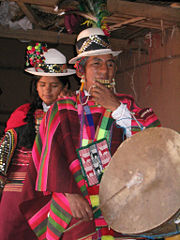
There are colonies of Mennonites in the department of Santa Cruz. Many Native communities interweave pre-Columbian and Christian symbols in their worship. About 80% of the people speak Spanish as their first language, although the Aymara and Quechua languages are also common. Approximately 90% of the children attend primary-school but often for a year or less. The literacy-rate is low in many rural areas, but, according to the CIA, the literacy rate is 87% nationwide, a rate similar to Brazil's, but below the South American average.
Culture
Bolivian culture has been heavily influenced by the Quechua, the Aymara, as well as by the popular cultures of Latin America as a whole.
The cultural development of what is present-day Bolivia is divided into three distinct periods: pre-Columbian, colonial, and republican. Important archaeological ruins, gold and silver ornaments, stone monuments, ceramics, and weavings remain from several important pre-Columbian cultures. Major ruins include Tiwanaku, Samaipata, Incallajta, and Iskanawaya. The country abounds in other sites that are difficult to reach and have seen little archaeological exploration.
The Spanish brought their own tradition of religious art which, in the hands of local native and mestizo builders and artisans, developed into a rich and distinctive style of architecture, painting, and sculpture known as "Mestizo Baroque". The colonial period produced not only the paintings of Pérez de Holguín, Flores, Bitti, and others but also the works of skilled but unknown stonecutters, woodcarvers, goldsmiths, and silversmiths. An important body of native baroque religious music of the colonial period was recovered in recent years and has been performed internationally to wide acclaim since 1994.
Bolivian artists of stature in the twentieth century include Guzmán de Rojas, Arturo Borda, María Luisa Pacheco, and Marina Núñez del Prado.
Bolivia has a rich folklore. Its regional folk music is distinctive and varied. The "devil dances" at the annual carnival of Oruro are one of the great folkloric events of South America, as is the lesser known carnival at Tarabuco.
The best known of the various festivals found in the country is the " Carnaval de Oruro", which was among the first 19 "Masterpieces of the Oral and Intangible Heritage of Humanity," as proclaimed by the UNESCO in May of 2001.
Entertainment includes football, which is the national sport, as well as table football, which is played on street-corners by both children and adults.



